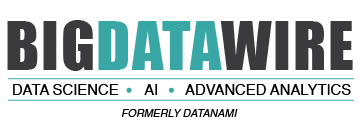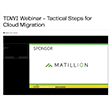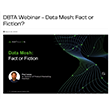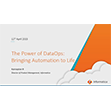
Improving Risk Evaluation Through Advanced Analytics

(Peshkova/Shutterstock)
The data we generate and copy annually doubles in size every two years, and IDC says it will reach 44 trillion gigabytes by 2020. That creates significant new opportunity for business. Indeed, as The Economist has noted, data has become more valuable than oil.
In the case of data, there’s a lot of it to wrangle from many sources. Ensuring you have the right data, that it’s fresh and that you’re using it to yield accurate results is challenging. And it’s quite complex.
Traditionally organizations have used people and manual processes to collect, review and report on data. That’s no longer a viable strategy. Manual systems simply can’t keep up with the growing volume of transactions and data processing required to make timely, informed decisions. Overwhelmed with higher demands and expectations for quality assurance, personnel and processes across industries have reached capacity.
Legacy rules-based analytical models don’t scale to meet today’s requirements for evaluating risk associated with this flood of data. Fortunately, technology innovation is fueling significant improvements in analytics. That’s enabling organizations to address the data onslaught and use it to their advantage.
Overcoming the Limitations of Legacy Rules-Based Models
Early decision models rely on hard-coded rules or very simple linear simulations with a limited number of features or variables. These models use sub-sampling and analyze cases as groups, ignoring important data sources that can impact outcomes. Restricted to making decisions at the group level, they are incapable of examining individual cases.
Legacy models also are limited by the perspective of those creating the rules, making it hard to incorporate unanticipated parameters. As new rules are added for each new case discovered, it becomes more difficult to see gaps and overlapping rules within hundreds of rulesets. This process yields too many false positives and exceptions. And over time it becomes too complex to maintain.
Automated decision-making is not new. Computers sift through data, spotting patterns and anomalies a lot faster than humans can. However, the application of artificial intelligence (AI) and machine learning is ushering in the next generation of analytics modeling using intelligent automation.
Improving Accuracy With Next-Generation Technologies
At first glance, intelligent automation approaches might seem similar to existing solutions, but technology innovation brings considerable change to the outcomes. New capabilities make more granular models possible, shifting from group to individual decisions.
Increased transaction volumes and higher data availability provide the inputs required for more accurate results. Greater processing power from cluster computing, distributed data management and cloud storage enable this data to be collected and used. Finally, advanced algorithms in AI and machine learning examine data fast and update frequently. And they learn from patterns and correlations to improve results over time.
Shifting the Roles of Rules
To take full advantage of new capabilities in AI and machine learning, the function of rules must shift. Instead of designing analytical models using rules to make decisions, businesses can develop rules of learning. This approach entails using algorithms to process all cases and examine individual behaviors. This allows organizations to move beyond sampling and segment-based treatments.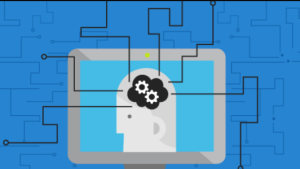
Sampling data only allows automated decision-making to identify segments that share high-level characteristics. This over-generalization increases the chances of false positives and negatives. While human intelligence remains a critical part of data analysis, it is limited to previously identified cases. Machine learning techniques, on the other hand, process huge amounts of data in real time to quickly identify newly emerging unknown patterns.
Even in known cases and with supervised learning, it is more efficient to let computer algorithms automatically find the relationships and causality analysis. Manually applying rules is error-prone and limited in terms of analysis and can be subjectively biased.
Deploying Advanced Analytics at Scale
Though many organizations are enthusiastic about adopting intelligent automation for risk assessment, few solutions are widely deployed in live operations. Challenges include a shortage of experienced data scientists, gaps between business and technology expertise, and a maturity curve for deploying prototyping tools at scale in the production environment. Most organizations have valuable data but face challenges drawing insight from it with no expertise in creating algorithms to extract knowledge. A lack of data science experience limits the sophistication of analytical models, and often the right technical personnel don’t have a deep understanding of the business. For more meaningful modeling, technical and business experts must work together to align with organizational goals.
Indeed, one report suggests America alone is short more than 151,000 data scientists. Another article indicates it will only get worse, as the need for data scientists is poised to increase 28% by 2020. A McKinsey Global Institute study about competing in a data-driven world comments on the data scientist shortage and related challenges.
“The biggest barriers companies face in extracting value from data and analytics are organizational. Many struggle to incorporate data-driven insights into day-to-day business processes,” McKinsey reports. “Another challenge is attracting and retaining the right talent – not only data scientists but business translators who combine data savvy with industry and functional expertise.”
Finally, many advanced analytical models in development today are prototypes. To reap the benefits of AI and machine learning, a model needs to scale in production. Hybrid approaches—building the model offline, generating insights and then manually building rules based on the insights—restrict the model’s capabilities. Transitioning from prototype to production is easier when partnering with third parties that specialize in integrating advanced analytics pipelines into operations.
To keep pace with a rapidly-moving, globally-connected digital world, analytics approaches that embrace intelligent automation will pave the way to faster, more accurate risk evaluation.
About the Author: Dr. Ali Akbari is the senior artificial intelligence lead at Unisys in Asia-Pacific, specializing in unstructured data and image processing. He has enabled the practical application of artificial intelligence and big data in multiple industries to address their real-life business challenges, including risk management. Unisys data scientists and subject matter experts put advanced analytics into practice, helping organizations in the public and private sectors to improve efficiency, assess risk and enhance customer experiences.
Related Items:
Beware of Bias in Big Data, Feds Warn
ADP Leverages Huge Database to Gauge Worker Attrition
Banks Consider the Rewards and Risks of Big Data
March 28, 2025
- Lockheed Martin and Google Cloud Partner to Advance GenAI for National Security
- Datadobi Releases StorageMAP 7.2 with Enhanced Metadata and Object Storage Discovery
- Carnegie Mellon Expands AI Research with Google-Powered Cloud GPU Cluster
- Trillion Parameter Consortium Partners with Tabor Communications to Launch Global AI for Science Conference, TPC25
March 27, 2025
- IBM Expands On-Prem Offerings with Storage Ceph as a Service
- Dataminr Partners with WWT to Launch Unified Cyber-Physical Threat Intelligence Platform
- Dataiku Announces 2025 Partner Award Winners
- Marvell Showcases PCIe Gen 6 Optical Interconnect for AI Infrastructure
- Akamai Launches Cloud Inference to Boost AI Workloads at the Edge
- Prophecy Introduces Fully Governed Self-Service Data Preparation for Databricks SQL
- Verdantis Launches Next-Gen AI Solutions to Transform Enterprise Master Data Management
- TDengine Releases TDgpt, Extending the Power of AI to the Industrial Sector
March 26, 2025
- Quest Adds GenAI to Toad to Bridge the Skills Gap in Modern Database Management
- SymphonyAI Expands Industrial AI to the Edge with Microsoft Azure IoT Operations
- New Relic Report Reveals Media and Entertainment Sector Looks to Observability to Drive Adoption of AI
- Databricks and Anthropic Sign Deal to Bring Claude Models to Data Intelligence Platform
- Red Hat Boosts Enterprise AI Across the Hybrid Cloud with Red Hat AI
March 25, 2025
- PayPal Feeds the DL Beast with Huge Vault of Fraud Data
- OpenTelemetry Is Too Complicated, VictoriaMetrics Says
- Accelerating Agentic AI Productivity with Enterprise Frameworks
- When Will Large Vision Models Have Their ChatGPT Moment?
- Your Next Big Job in Tech: AI Engineer
- The Future of AI Agents is Event-Driven
- Data Warehousing for the (AI) Win
- Nvidia Touts Next Generation GPU Superchip and New Photonic Switches
- Alation Aims to Automate Data Management Drudgery with AI
- Can You Afford to Run Agentic AI in the Cloud?
- More Features…
- Clickhouse Acquires HyperDX To Advance Open-Source Observability
- NVIDIA GTC 2025: What to Expect From the Ultimate AI Event?
- Grafana’s Annual Report Uncovers Key Insights into the Future of Observability
- IBM to Buy DataStax for Database, GenAI Capabilities
- Google Launches Data Science Agent for Colab
- EDB Says It Tops Oracle, Other Databases in Benchmarks
- Databricks Unveils LakeFlow: A Unified and Intelligent Tool for Data Engineering
- Reporter’s Notebook: AI Hype and Glory at Nvidia GTC 2025
- Weaviate Introduces New Agents to Simplify Complex Data Workflows
- Mathematica Helps Crack Zodiac Killer’s Code
- More News In Brief…
- Gartner Predicts 40% of Generative AI Solutions Will Be Multimodal By 2027
- Snowflake Ventures Invests in Anomalo for Advanced Data Quality Monitoring in the AI Data Cloud
- NVIDIA Unveils AI Data Platform for Accelerated AI Query Workloads in Enterprise Storage
- Seagate Unveils IronWolf Pro 24TB Hard Drive for SMBs and Enterprises
- Accenture Invests in OPAQUE to Advance Confidential AI and Data Solutions
- Alation Introduces Agentic Platform to Automate Data Management and Governance
- Gartner Identifies Top Trends in Data and Analytics for 2025
- Qlik Survey Finds AI at Risk as Poor Data Quality Undermines Investments
- Palantir and Databricks Announce Strategic Product Partnership to Deliver Secure and Efficient AI to Customers
- HighByte Launches API Builder for Industrial Data
- More This Just In…
